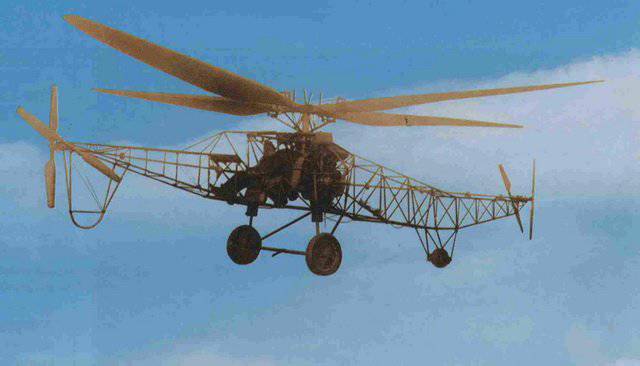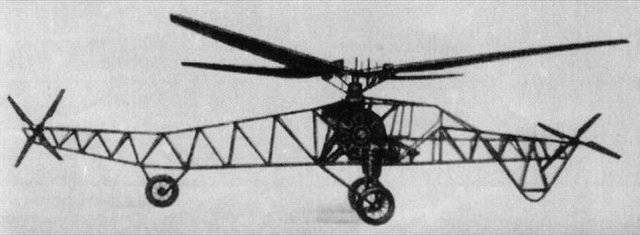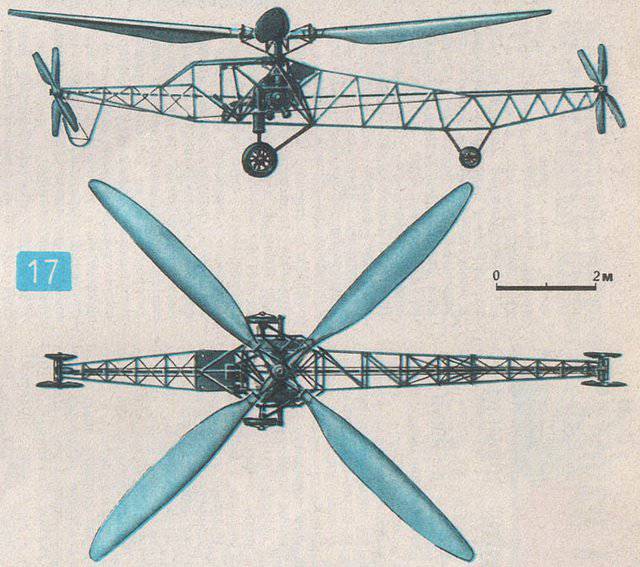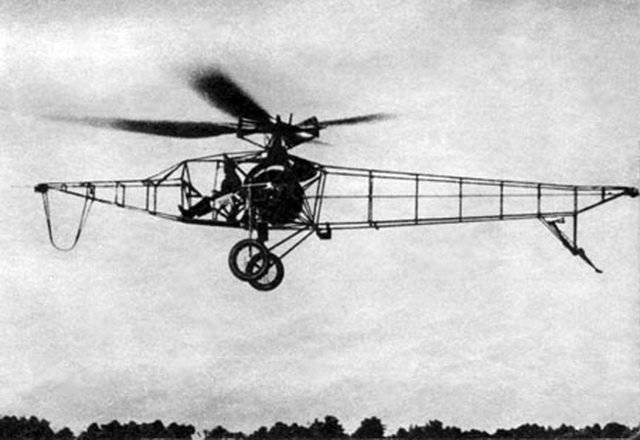Helicopter Cheremukhina
Later, many years after this flight, the famous Soviet aircraft designer A.N. Tupolev said: “At one time we did not manage to publish the record flight of Cheremukhin, which, undoubtedly, could bring world-wide fame to the Russian helicopter.” The first domestic helicopter was built under the direction of A. M. Cheremukhin. The helicopter, which was piloted by the designer himself, first flew into the sky in the 1930 year. Already in September, the pilot was free to perform various maneuvers at an altitude of 1930-10 meters from the ground, in late autumn of the same year he flew at an altitude of 15-40 meters. And this is already in 50-2 times higher than the official world record, which was set on the Italian helicopter Ascanio. 2,5 August 14 of the year, rising to a height of 1932 meters, Cheremukhin surpassed the official world record immediately 605 times.
The history of the helicopter
The history of the first Soviet helicopter should begin with its creator. Alexei Mikhailovich Cheremukhin was born in 1895 in Moscow in a family of teachers. In 1914, the future Soviet aircraft designer graduated from the 5th Moscow classical gymnasium with a gold medal. In the same year he entered the St. Petersburg Polytechnic Institute. However, the beginning of World War I forced him to leave his studies at the institute. Alex goes to the army in the 13th corps aviation detachment in the role of a volunteer. In June 1915, he was transferred to the Aviation School of the Imperial Moscow Aeronautical Society, where he took 4 years "Theoretical Courses" by N. E. Zhukovsky. At these courses, Cheremukhin gets acquainted with Tupolev.

Upon completion of the course, at the beginning of February, 1916, after passing the exam for the pilot, Alexey Cheremukhin was sent to the 4 of the Siberian corps aviation squad of the southwestern front. 24 March of the same year he was awarded the title of ensign. In April, 1916, for the first time, Cheremukhin makes a combat flight, and on December 12, 1916, he was awarded the title of “military pilot”. In total, during World War I, he carried out 140 combat missions, which were associated with fire adjustment, reconnaissance, and fighter cover.
For courage and courage shown during the service, he was awarded a number of orders: Order of St. Anne II degree with swords, III degree with swords and bow, IV degree with the inscription "For Bravery", the Order of St. Vladimir IV degree with swords and bow, orders of St. Stanislav II degree with swords and bow and III degree, as well as the highest military award of France - the Order of the Military Cross, also the pilot was presented to the award of St. George weapons. 20 December 1917 of the year A. M. Cheremukhin was appointed an instructor at the Kachin Military Aviation School located in Sevastopol, but after its disbandment in March 1918, he returned to Moscow.
After his return to the capital, from the first days of the organization of the Central Aero-Hydrodynamic Institute (TsAGI) he worked in it together with other famous students of Professor N. Ye. Zhukovsky, and was directly involved in the creation of the first Soviet aviation research institution. It was he who in 1927 was entrusted with becoming the head of TsAGI's work on the design of screw devices (autogyros and helicopters). The result of the general work of the group was the TsAGI 1-EA helicopter. At the same time, Cheremukhin not only engaged in the design and construction of the first Soviet helicopter, but also piloted it himself during the tests.

The development of helicopter technology at TsAGI began in the 1925 year, led by B.N. Yuriev. The year before, it was he who headed the experimental-aerodynamic department, which included a special helicopter group, headed by Cheremukhin. In addition to him, this group included young enthusiasts of the helicopter industry: V. A. Kuznetsov, I. P. Bratukhin, AM Izakson. In the future, the group was joined by M. L. Mil, N. K. Skrzhinsky, N. I. Kamov, and V. P. Lapisov, who worked on autogyros, are future well-known Soviet designers of helicopters. Together with Cheryomukhin, other Soviet engineers also worked, who in the future became leading experts in their field.
First of all, the developers were engaged in conducting theoretical studies of various schemes of helicopters and the main rotor. After that, experimental studies of the rotor with a diameter of 6 meters were started on the field stand built at TsAGI. Later, in 1928, work began on the creation of an experimental helicopter. The first experimental helicopter created in the Soviet Union was designated TsAGI 1-EA (stands for the first experimental device). It was decided to create the helicopter according to the scheme that was proposed and created as early as 1909-1912 in the year B. N. Yuryev.
In July, 1930 of the year, having developed unique, purely helicopter units, among which were: a central gearbox, a four-blade main rotor, one-way clutches, and other elements of an extensive, complex transmission, the specialists began full-scale tests of the first helicopter. The unusualness of the aircraft was matched by the situation in which the first launches were carried out. Without risking immediately relocating the helicopter to the airfield (suddenly serious alterations would be needed), the team of creators involved in building the car settled directly on the 2 floor of the unfinished TsAGI building. Here, in the presence of a firefighter with a full set of fire extinguishing agents, Alexey Cheremukhin, who was also a test pilot in combination, conducted the first, so far only ground tests of TsAGI 1-EA. After these tests were carried out, the helicopter was delivered at night to the Ukhtomsky airfield, which was specially allocated for the testing of the new aircraft by MN Tukhachevsky, Deputy People's Commissar for Military and Naval Affairs.

The TsAGI 1-EA helicopter was made using a single-rotor scheme using a four-blade main rotor and X-NUMX-x rotary piston engines M-2, which developed 2 horsepower. each. Also used 120 tail rotors, which were installed in pairs in the tail and nose parts of the truss fuselage of the machine and equalized the jet torque of the main screw. The rotor had a diameter of 4 meters, and its 11 blades were of mixed construction with wooden ribs and stringers, a metal spar and linen skin. The blades differed in a rather complex elliptical shape and perfect for that period of time aerodynamic layout, which allowed the helicopter to provide high traction characteristics. TsAGI 4-EA was equipped with a tricycle landing gear with a tail wheel, like the aircraft.
The TsAGI 1-EA helicopter implemented a system for controlling the cyclic and common pitch of the main rotor blades using a special swashplate designed by B. N. Yuryev. Deviations and movements of the skewer were made by deflecting the common pitch lever and control knobs. Also, with the help of a common pivot lever, the helicopter’s rotor could be transferred to a small pitch that was necessary for the machine to switch to the autatorising motorless descent mode. In order to deploy the helicopter, it was enough just to change the pitch of the tail rotors - this was achieved by deflecting the foot pedals that were connected to the steering rotor mechanisms with special cables. In the future, this control system has become traditional for all single-rotor helicopters equipped with a tail rotor.
Unfortunately, for several reasons, TsAGI 1-EA, like many other helicopters built in those years by the engineers of this center, was not destined to become the prototype of any production machines, but without them the formation of a national helicopter building school simply cannot be imagined. Many of those who worked in the 1920-30 years to create the first Soviet helicopters, forever inscribed their names in the history of the Soviet aircraft industry, having survived the years of repression and war.

Flight technical characteristics of TsAGI 1-EA:
Dimensions: main rotor diameter - 11,0 m., Length –12,8 m., Height - 3,38 m.
Screw speed - 153 r / min.
The mass of the helicopter: empty - 982 kg, maximum take-off - 1145 kg.
Type of power plant: 2 PD M-2, power 2x88 kW (2x120 hp).
The maximum flight speed is 30 km / h.
Maximum flight ceiling - 605 m.
Crew - 1 man.
Information sources:
-http: //vadimvswar.narod.ru/ALL_OUT/AiKOut09/HelRecHi/HelRecHi007.htm
-http: //nnm.ru/blogs/dzhi-day/vertolet-cagi-1-ea-cheremuhina-sssr-1930-god/#comment_19178400
-http://xn--b1adccaencl0bewna2a.xn--p1ai/index.php/articles/military-equipment/54-military-equipment/10905---1----1930-
Information